It’s raining as I write this, which brings to life right out my window all of the things I like about using wood chips as mulch around my vegetables. The chips are soaking up the rain so there’s no run off; they’re protecting the soil surface from erosion or crusting — there’s not even any splashing of dirt or compost up onto the leaves of plants; the rain will germinate weed seeds elsewhere but not where there’s a thick layer of wood chips; I can take a walk out there over the wet soil because the chips absorb my footsteps so well. In fact, I think I will.
Have a look at the structure of the wood-chip mulch under this cauliflower plant.
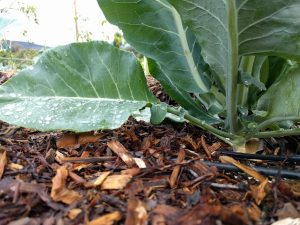
Notice this: there are chunks of wood, bark, twigs, and leaves of different sizes that don’t fit together well, therefore leaving lots of little caves and crevices. It’s this very quality that allows wood chips to be such a splendid mulch, but unfortunately also engenders its single downside.
The one downside of wood chips as mulch around vegetables
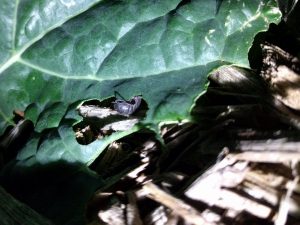
See that pill bug? That’s the downside. All of those caves and crevices created in a wood-chip mulch provide a perfect habitat for some garden pests, especially pill bugs, sow bugs, earwigs, snails, and slugs.
So there’s no free lunch — not even when you get a free load of wood chips delivered. Spread them on your garden paths and under your vegetables and you invite these critters.
I’ll later mention how I continue to use wood chips as mulch on my vegetables while managing the critters they harbor. But for now, let me note that any other mulch will also harbor these pests to some degree, and even if you don’t mulch, these guys will still find hospitable places nearby, like in between the bricks of a path or at the corner of a wall.
Let’s hear a bit more about the benefits of using wood chips as mulch around vegetables to see if they might outweigh this negative for your garden’s situation too.
Wood chips have great water-holding capacity
Last winter was a dry one for Southern California, yet my lettuce that was mulched with wood chips never seemed to need irrigation as often as I thought it should. I’d pull back some chips and it was still so moist underneath. It was like the chips had soaked up what little rain did fall and then metered it out to the shallow lettuce roots.
Mulches of leaves or compost also conserve moisture, but in my experience wood chips allow vegetables to go even longer between waterings.
(Want to grow some lettuce? Check out: “Growing and harvesting lettuce in Southern California.”)
Wood chips keep plants clean
Speaking of lettuce, look at the dirt and compost splashed all over these leaves by the rain today.
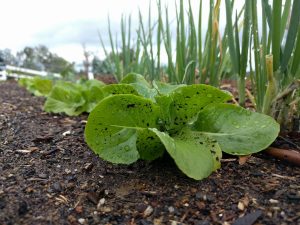
There are a couple of garden chores I dislike, and having to wash vegetables before eating them is one. I had spread compost under those lettuce plants when putting them in, but they weren’t quite big enough to spread wood chips under before this last rain started. Compost as mulch doesn’t prevent the splashing; wood chips does.
Here are some mature lettuce plants from last year with wood chips under them. They stay so clean that I never need to wash them before eating, although I do usually pick off and discard a couple of outer leaves when harvesting a full head.

Wood chips make clean paths between garden beds
In a similar vein, covering paths between the rows or beds of your garden with wood chips allows you to walk around without getting your shoes mucky, even while it’s raining. The wood chips just don’t stick to anything, no matter how wet.
Wood chips suppress weeds
Another great effect of a wood-chip covered path is that you don’t have to deal with weeding there. As long as you keep the mulch thick, almost no weeds will grow in your paths. The exceptions are the few seeds that fly in from a wind and perennial weeds like Bermuda grass.
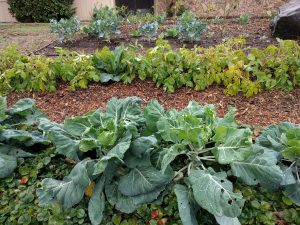
Weeding is the other garden chore that I dislike, so I appreciate that a mulch of a couple inches of wood chips essentially eliminates it. Of course, mulching within the rows of vegetables, right around the plants, accomplishes the same, especially if you don’t dig. (See more about weeding in my post, “How to outsmart garden weeds.”)
Wood chips protect soil structure
You may have heard the advice that it’s bad to walk on your garden soil while it is wet. It’s good advice; you can feel the soil compacting under your feet when you do. Even where I have compost as mulch, the soil still compacts a bit. Not so if there’s a thick layer of wood chips, however.
This was shown clearly to me a couple of winters ago when I raked the wood chips off a path that I’d been using for years. I sowed peas into the soil below straight away — no digging, no amending. I expected I’d have mashed the soil under there after walking on it for so long, but I sowed the peas right into it just to see what would happen.
I know this sounds suspicious, and I’m not sure of the explanation, but what emerged was the best crop of peas I’ve had to this day.

That’s my best crop of peas on the right, and on the left are the little humans who feasted on them.
What I do know after that pea crop is that wood chips certainly protect the soil structure well.
Wood chips won’t require added nitrogen
I should mention that you need not pay mind to the idea that spreading wood chips as mulch will “tie up” nitrogen and require that you add nitrogen fertilizer in order for your vegetables to grow well. This statement is found here and there, even parroted by people who you’d think you could trust, but never is any evidence given.
Just remember that we’re talking about mulch here. Mulch is something we lay on the surface and don’t dig into the soil.
The only field research I’ve ever seen was this cool 15-year study done over 50 years ago on a farm in New York where it was found that using wood chips as mulch on vegetables had higher yields compared to no mulch or cover crops. (This paper by Brian Caldwell of the University of Vermont recounts the study.)
My garden has never shown a nitrogen problem after a mulch of wood chips was added. Here is some corn growing this summer among wood chips. I’ve added no fertilizer. The tall stalks, green leaves, and good-sized ears indicate that all is well down in the soil.

Managing pests with wood chips mulching vegetables
Back to the one downside that I’ve experienced with wood chips, that is, garden pest habitat. Here is how I mitigate that problem. When I am going to sow seeds or transplant vegetable seedlings, I rake back the wood chips so they’re only on the paths. When I do this, I usually see some surprised, scared pill bugs wondering where their home went. What I’m aiming to do is give them no shelter close to my baby vegetable plants, which reduces their feeding on them. All animals are as lazy as we are and will eat as close to home as possible.
I sometimes add some compost to the surface of the soil at this time. Then I sow or plant.

Once vegetable plants are big enough to sustain a little nibbling, I start to bring the wood chips back around them.
I also periodically put my chickens over a vegetable bed to eat all of the bugs in that area. This works well, but it’s not perfect because chickens don’t particularly like pill bugs. They’ll eat every earwig, slug, etc. — almost none of those critters exist in my vegetable garden anymore — but they won’t eat all the pill bugs. (For more on the chicken routine, see my post, “Chickens: my garden’s little helpers.”)
If you don’t have chickens, you might look into a product called Sluggo Plus (see it here at Peaceful Valley Farm Supply). I’m not recommending it exactly because I’ve never used it myself, but I have been told by friends who aim to use few pesticides that it is effective on the garden pests that wood chips and other mulches give harbor to.
Wood chips as mulch on vegetables aren’t perfect, but I find that their benefits far outweigh their single drawback. If you have access to some, try them out. You might find them similarly useful among your vegetables.
Worries about certain kinds of wood chips?
An often-repeated notion is that wood chips from certain kinds of trees such as eucalyptus or black walnut will be toxic to plants, and another often-repeated notion is that wood chips can spread diseases. However, neither of these claims has ever shown itself to be true in my experience nor in any study that I’m aware of.
See: “Using arborist wood chips as landscape mulch” by Linda Chalker-Scott of Washington State University.
And see: “The myth of pathogenic wood chips” also by Chalker-Scott.
All of my Yard Posts are listed HERE
This website has no ads because of the wonderful, direct support from gardeners like you. Learn more about supporting The Yard Posts HERE

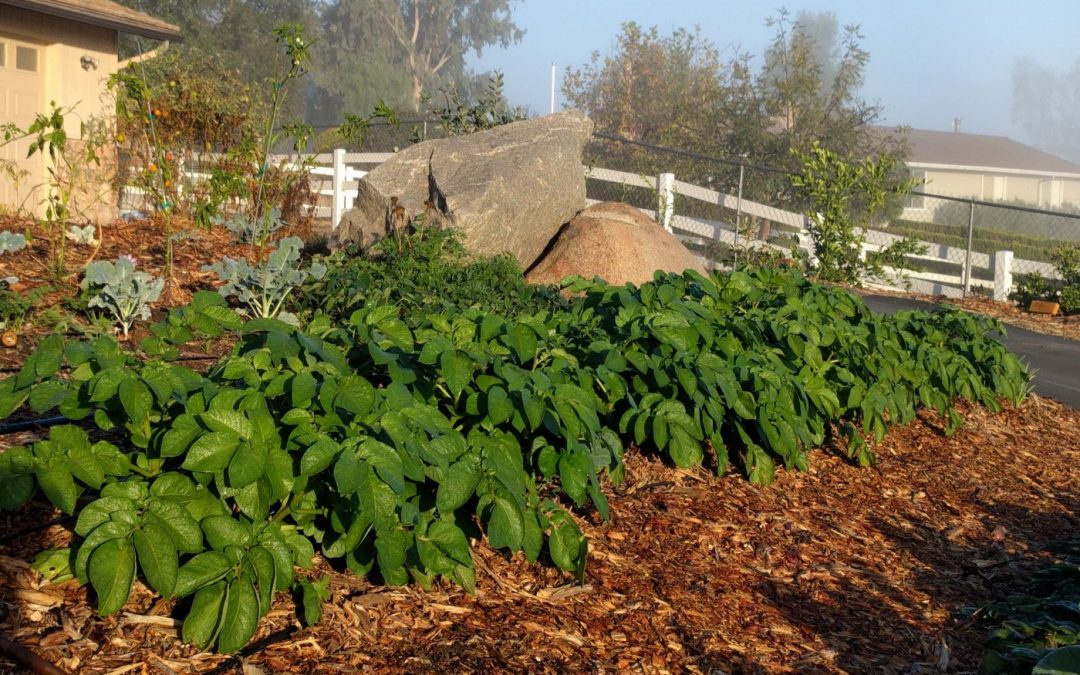


Great information- thanks!
Hi Greg,
I have two raised/elevated 4×8′ garden boxes. Could I use mulch in there? I need something bcz so far not a lot of bounty but I’m a new gardener with lots to learn. I’ve heard straw is good too. What do you think is best for small off the ground veggie boxes? Thank you!
Hi Lisa,
In a raised box for vegetables, I’d use a mulch of compost rather than wood chips. It’s OK to use wood chips, but since you’re not walking on the soil up there it’s not as useful. The compost, on the other hand, will improve the soil fertility and structure, retain moisture, suppress weeds, etc. Just lay down an inch or two of compost on the surface once or twice a year and you’ll gradually see improvements in your plants. Eventually, you should never need additional fertilization either.
Hello,
I really enjoyed your post. Thank you!
After years of gardening using raised beds, we moved to a new property and did the ‘no till’ method for the first time. We put cardboard on the ground and let it get nice and wet and sit for a long time. Then we put horse manure, organic compost and soil. We then put wood chips on the top.
We have two big problems:
One, the soil is way too wet. This is something we just had to learn the hard way. We were used to watering (we use a drip irrigation system) much, much more when not using wood chips! Our plants began yellowing and struggling and that is when we found the soil was water-logged. Silly. We should have checked it before the plants yellowed!
Second problem is earwigs. Oh. My. Goodness. We have lost most of our pumpkin plants and most of our beans and some flowers such as Zinnias. I have used SluggoPlus but the damage continues. When I dig in the chips, I uncover hundreds of earwigs.
We are getting chickens but not for another month or two.
I like your idea of moving the chips away from the baby plants until they are established. I am going to do that today.
Thank you for your post and for sharing your knowledge.
Hi Wendy,
There is so much for me to relate to here! I didn’t water my vegetables one time all last winter because of the water-holding capacity of the wood chips along with the consistent rains. Yet, I had some pea plants die because the soil was still too wet. I had to scrape the wood chips back farther from them and then the replants did better.
I have dry-farmed many things because of the wood chips: sweet potatoes, strawberries, squash, garlic. The wood chips hold water and keep the soil below so moist that you can get production from some crops from residual rainfall through the spring and into summer, no watering ever, in inland Southern California. It’s amazing.
Earwigs, my nemesis. The good news is that once it heats up, which should be by the end of June, they mostly disappear for the rest of the year. They’re mainly a problem here in spring. So I’ve taken to planting the crops they like later. This includes basil and peppers, particularly, but also pumpkins, melons, and beans, as you have experienced.
Wood chips in the vegetable garden are a trade off, not a perfect solution to any problem. You get water-holding capacity and fertility and no mud on shoes and cleaner lettuce, etc., but you also get the negatives above, unfortunately.
My seedlings were attacked this spring by earwigs. I had previously used homemade traps of 50/50 soy sauce and olive oil in the bottom of a solo cup to keep them out of our home. I placed a cup in each raised bed and never had another problem again. They caught so many other undesirable insects as well. I’ll definitely start out with them next spring.
Just found your blog a few weeks ago and it’s so helpful! Thank you for sharing all of your experience.
What do I do at the end of the garden season when it comes to the wood chips? Till them? Leave them?
Hi Giselle,
Here in Southern California there is no beginning or end to the garden season, but if I’m not using a bed for a while I just leave the chips in place. I don’t till them. When I’m ready to plant again, I rake them back a few inches so I can plant directly into dirt.
Hey Greg,
Have you ever had issues with grubs invading your beds? I tried searching on your blog, but nothing came up. I recently had to rake away my entire compost mulch because there were a bunch hiding underneath as I was getting ready to transplant. ;( You do have chickens though, so maybe they take care of them for you?
Hi Arden,
If I leave the chickens over a bed long enough they will unearth and consume all of the grubs, no doubt. But when I haven’t let the chickens do that I haven’t noticed problems due to the grubs. One exception is from my previous yard where I didn’t have chickens but we had many skunks and raccoons. They would dig for the grubs and destroy many vegetable seedlings inadvertently.
I do find grubs when I’m transplanting sometimes in my current vegetable beds, and I do take them over to the chickens because it’s such a treat for them, but I’ve never noticed the grubs themselves causing problems to my vegetables. I have read about issues with grubs feeding on roots, but I’ve never observed such damage in my own garden. It might be because I don’t have very many grubs though.
My experience with grubs is they were fruit beetles which are awful In adult stage. Large jewel like green, big as your thumb and destroy your fruit crop. So bring on the chickens or destroy them yourself.
Greg…how do you (or others) manage the wood chip mulch at the end of the season? What happens if it gets tilled into the soil in the fall or in the spring before planting?
Thank you
Hi Will,
Here in Southern California there is no real end to the gardening season; there’s just a cool half of the year and a warm half of the year. I don’t do anything with the wood chips throughout my vegetable garden except occasionally rake them back if they’re encroaching on a bed that I want to plant or that I want to spread compost on. Otherwise, I just leave them on the surface.
Eventually the wood chips will break down and feed the soil. I’ve had to add additional wood chips to my BTE garden. That’s the great thing.. the leaves and wood chips continually feeds the garden.
Hi Greg,
We are about to put down some small bark chips, but I wanted to run it past you first. Is bark ok for under fruit trees? I think it is Douglas Fir bark. Also I also wonder if you know anything about Doug Fir bark making you itch or feel like you have very small splinters in your skin after touching it? We have a dog too and I am a bit afraid of her getting it in her paws.
I come to you as a resource and thank you very much for your posts!
With much thanks,
Steven
Hi Steven,
Thanks for the kind words. I don’t know about Douglas Fir bark making you itch. I do have a friend who put bark chips (can’t recall which kind, but wouldn’t be surprised if they were Doug Fir) under his Hass tree, and they have done no harm.
A downside of bark chips that I’ve observed is that they don’t break down nearly as fast as arborist wood chips. The arborist wood chips break down faster and form a nice layer between the chips and the soil of black, rich humus where you find many worms and avocado roots after a few years.
Hi Greg,
Thanks again for your insight. I have contacted the company that trims our trees and they will bring a load after one of their jobs. Bark is a bit prettier, but looks ain’t everything, right? lol I will be happy to make the plants happy with the nutrients that are found in arborists wood chips.
I am not sure if this is kosher, but could I ask you about how to deal with Apple Tree Fire Blight here? It is a 6′ tree I bought and had planted about 6 months ago. A four variety tree and it seems the Anna has been hit the worst. I bought Fertilities-Lome Fire Blight Spray, but I am not sure if i should use it and also if I should cut the infected branches way back. If this is the wrong place to ask I am sorry. I did search for Fire Blight on your blog first ;^)
Kind regards from L.A.,
Steven
Hi Steven,
Thanks for doing the search first! I haven’t written anything about fire blight because I haven’t dealt with it much, luckily. So I really only know what I’ve heard and read. My initial go-to source in situations like this is the UC IPM site. Here’s their page on fire blight: http://ipm.ucanr.edu/PMG/PESTNOTES/pn7414.html
Hi Greg,
Thank you. It is so odd, there are new blooms happening now, just like your new blog post is talking about. I have sprayed the flowers with a copper sulfide, but I think they are still dying. I scrapped just under the skin of the branches and they look fine and green, but I guess the only solution is to trim the branches way back.
Hey Greg,
I’m looking at mulching my garden with wood chips from the local tree service. We have lots of Black Walnut in our area, and I’ve heard to avoid wood chips from that species because of the toxic/allelopathic effects on other plants. I’ve heard some resinous pines can have negative effect on certain vegetables, but doing some research I couldn’t find anywhere what type of tree is best for veggie mulching.
What has worked best for you? I realize you’re on the west coast, I’m in the mid-Atlantic region (lots of hardwoods), but do you know if it even matters which kind of tree I get for mulching?
Hi Marci,
I’ve never used black walnut (knowingly), but I would if I had the opportunity. I personally don’t buy the idea that wood chips of certain species have significant toxic or allelopathic powers because I’ve never found any evidence for it, not in my own gardens nor in anyone else’s yard nor in any study. It seems to be an idea that people just keep repeating without any evidence to back it up.
Specifically, as regards black walnut, Linda Chalker-Scott of Washington State writes, “Even Juglans nigra (black walnut), the best known allelopathic species, has not been shown to have negative effects when wood chips are used as a mulch.” The quote comes from here: https://www.researchgate.net/publication/315662938_Using_arborist_wood_chips_as_a_landscape_mulch_WSU_Extension_Fact_Sheet_FS160E
I use every type of wood chips I can get except thorny stuff or palms (because they are so fibrous and clumpy). I especially like to mix types because that’s how it’s done in nature so I figure it ought to work.
Steven, I have avocado, citrus, pear, peach, cherimoya, fig, plum, etc. and they all get as thick a layer of wood chip mulch as possible – usually about 3″. I buy them from Lowes and Home Depot when on sale, although since the plandemic I have not seen them on sale this year. I was using Kellogg’s grow mulch, but I’ve had better results with the wood chip mulch. It holds in the moisture and it slowly degrades into the soil, so I usually add more each year. The lowes product is called “Premium Hardwood Mulch”. I think it is made by debarking trees. The only downside so far has been a few strange mushrooms that are likely from spores in the mulch.
Hi Richard, Thanks! I finally decided to go with a load of mulch from our tree pruner. Much cheaper and has a variety of wood chips, small branches and leaves. The only thing I had seen at some point regarding Doug Fir Bark mulch was that it was not goo for fruit trees, but maybe that is a myth? And yes, I do get the oddest mushrooms in the mulch! :-O
Great article. I was particularly looking for info on the idea that wood chips steal nitrogen. Your observation of how ‘facts’ often spread by virtue of the fact that most advice posted online, for example, is second hand and not from direct experience, creating a chain of misinformation, is exactly what I have experienced lately as a novice vegetable gardener trying to improve my knowledge. I have just bought a bag of wood chips, tested and of excellent quality to experiment with my vegetable garden. I also have a good amount of straw/thatching which I have used on a few beds. Then I’ve use fairly well decomposed leaves from the bamboo growing around my area. What are your thoughts and advice as I experiment with these sources of mulch? Should I forget about the nitrogen problem with wood chips or would it be better to use the other mulches?
Hi Mike,
Thanks. Yes, I would forget about the myth of wood chips stealing nitrogen. The mulches might cause other problems, such as snail and slug habitat, but nitrogen tie-up won’t be one of them. Still, you might need to add a source of nitrogen if your soil is inherently low. Vegetables sure do grow better in fertile soil, from my observations.
Hi Greg,
We started a raised bed garden this spring. This was a project for the whole family. So we started out sectioning off the 4X8 boxes and tilling the ground working the miracle grow garden soil, fertilizer, and compost together. We planted our vegetables seeds and some potted vegetables. Afterwards we put wood chips all around the garden. Did we do any thing wrong? Will our seeds grow through the wood chips and will I have bugs. We live in the great state of Texas.
Hi Greg, Sorry if you answered this already, but do you mat (carboard or newspaper) before laying your wood chips?
Hi Sarah,
I don’t do this in my own garden. I just put the wood chips directly into the dirt. But cardboard first might be helpful if you have certain weeds such as Bermuda grass.
SO I am having an issue with Bermuda growing up through a layer of cardboard, then compost and then mulch. I have a fruit tree guild that is planted already with trees and supporting plants. Will the Bermuda grass just keep coming back no matter how thick I make the mulch? Am I doomed with the grass??
Hi April,
I can relate. I have lots of Bermuda grass around my yard too. It’s tough but not unstoppable.
You probably can’t make the mulch thick enough to stop it. I wouldn’t bet on that approach. I’ve had Bermuda take over mounds of mulch that were five feet tall.
I would try to starve the root system by continually pulling out the top growth, which is what I do. Here in spring, Bermuda really gets growing and it goes all through summer. So what I do is continually pull out all the Bermuda I see during this season, and then you’ll notice the growth greatly slowing as the weather cools later in the year. Next spring, you’ll probably see much less regrowth, and you’ll start to feel like you are now in control. Eventually, the Bermuda root system will be killed in that area because it wasn’t able to grow enough leaves above ground to make food for the roots, and you just have to watch for it creeping in from outside that immediate area from then on.
You are not doomed. I’ve eliminated Bermuda from many areas in my yard using this approach. In fact, I no longer dislike Bermuda so much now that I know I can deal with it in this way. There are so many worse weeds.
So glad to find your discussions on wood chips back I just got my first huge pile from arborists who destroyed two hundred plus year old trees.
Instead if bringing the mulch to the wheel narrow, I am saving my energy by taking the barrow to the chips.
I intend to direct plant from seed and mulch with the chips.
And as you suggest, I am going to put my two trees worth if mulch in my paths to cut down on dirt on my shoes
I do have one question for now: should I put the chips on the green plants that have grown up voluntarily since last spring? Or do I need to weed first?
Hi Annette,
You can smother the weeds if you put enough wood chips over them, unless they are certain weeds like Bermuda grass. If possible, I would mow the weeds short first and then lay down the wood chips. A layer of chips at least three inches deep should do the smothering trick.
I’m wondering what happens if you plan to till the garden in the fall. Do you need to scrape off those layers of wood chips or do you roll them right in and mulch again in the spring after planting ?
Hi Mallory,
I don’t till, but if I did I would rake the chips back before tilling. Sometimes I fork my beds to loosen the soil a bit, and when I do I first rake the chips back into the path.
I used to worry a lot about raking away wood chips before turning over the soil. Then, I noticed that when wood chips did get incorporated, the resulting soil the following year had much better tilth. I’m not talking about purposely adding chips, just not caring if a layer a couple inches thick (at the end of the season) gets turned it when I’m prepping the bed for the next crop. I haven’t seen any signs of nitrogen deficiency or poor growth due to chip decomposition in the soil. If I had a tick layer of chips (3-6 inches), I rake it away.
Thank you very much for contributing this, Warren. I too have never noticed the nitrogen deficiency that is so commonly warned about if wood chips get incorporated into the dirt. I don’t purposely incorporate them, but I never worry about incidentally incorporating some, which always happens when I hill up potatoes with wood chips, for example. (At harvest, the chips always get mixed into the dirt in that area somewhat, but the following crop planted there grows fine.)
In my experience, the wood chip / nitrogen deficiency relationship is exaggerated at best. And the only people I hear warning about it do not do so based on firsthand experience.
hello i have garden snakes in my garden. i know they are beneficial to the garden, but i am terrified of the them. do you have any suggestion to repel them, also will the would the wood chips increase their presence due to the critter population ?
Do the arborist woodchips need to dry out before you use them or are fresh from the tree OK for use around vegetable plants like squash, cucumbers and peppers